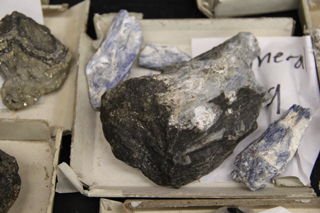In this section, Prof. Perron discusses how the course challenges students to make sense of complexities in the field.
The real world is messy, and we’re asking them to make sense of that messiness. That comes as a shock for many students.
—Taylor Perron
Many of our students are accustomed to classes that have assignments in which the problems are clear-cut and have precise answers. The earth sciences are not like that. For example, we might ask students to identify three different rock hand samples that all appear rough and grayish. Students don’t always know how to approach a problem like that.

Students learn to identify rocks and minerals in the first two labs of the course. (Image by MIT OpenCourseWare.)
Similarly, some become easily frustrated when they approach a road cut and the rock is partly covered with soil, broken up, weathered, and has minerals that are not as well exposed as they might be. The real world is messy, and we’re asking them to make sense of that messiness. That comes as a shock for many students. Geology is not plug and chug. There’s always extraneous information in the field. And the good stuff—critical details—is always missing!
Although we do have students solve equations, we emphasize problems that involve critical thinking and incomplete evidence because that is what students will encounter in the field. In 12.001 we strive to help students feel okay about dealing with the uncertainties involved in making measurements in the field and using incomplete sets of observations to piece together a story. Once they get the hang of it, the students do really well!
